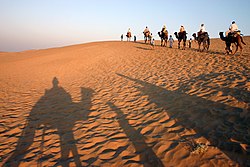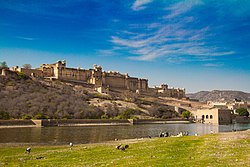Rajsthan biography
Rajasthan
Rajasthan (/ˈrɑːdʒəstæn/ Hindustani pronunciation: [raːdʒəsˈtʰaːn] ( listen); literally, "Land of Kings")[7] is a state in northern India.[8][9][10] The state covers an area of 342,239 square kilometres (132,139 sq mi) or 10.4 percent of the total geographical area of India. It is the largest Indian state by area and the seventh largest by population. Rajasthan is located on the northwestern side of India, where it comprises most of the wide and inhospitable Thar Desert (also known as the "Rajasthan Desert" and "Great Indian Desert") and shares a border with the Pakistaniprovinces of Punjab to the northwest and Sindh to the west, along the Sutlej-Indus river valley. Elsewhere it is bordered by five other Indian states: Punjab to the north; Haryana and Uttar Pradesh to the northeast; Madhya Pradesh to the southeast; and Gujarat to the southwest.
listen); literally, "Land of Kings")[7] is a state in northern India.[8][9][10] The state covers an area of 342,239 square kilometres (132,139 sq mi) or 10.4 percent of the total geographical area of India. It is the largest Indian state by area and the seventh largest by population. Rajasthan is located on the northwestern side of India, where it comprises most of the wide and inhospitable Thar Desert (also known as the "Rajasthan Desert" and "Great Indian Desert") and shares a border with the Pakistaniprovinces of Punjab to the northwest and Sindh to the west, along the Sutlej-Indus river valley. Elsewhere it is bordered by five other Indian states: Punjab to the north; Haryana and Uttar Pradesh to the northeast; Madhya Pradesh to the southeast; and Gujarat to the southwest.
Major features include the ruins of the Indus Valley Civilisation at Kalibanga and Balathal; the Dilwara Temples, a Jain pilgrimage site at Rajasthan's only hill station, Mount Abu, in the ancient Aravalli mountain range; and, in eastern Rajasthan, the Keoladeo National Parknear Bharatpur, a World Heritage Site[11] known for its bird life. Rajasthan is also home to three national tiger reserves, the Ranthambore National Park in Sawai Madhopur, Sariska Tiger Reserve in Alwar and Mukundra Hill Tiger Reserve in Kota.
The state was formed on 30 March 1949 when Rajputana – the name adopted by the British Raj for its dependencies in the region[12] – was merged into the Dominion of India. Its capitaland largest city is Jaipur. Other important cities are Jodhpur, Kota, Bikaner, Ajmer and Udaipur. The economy of Rajasthan is the ninth-largest state economy in India with ₹9.24 lakh crore (US$130 billion) in gross domestic product and a per capita GDP of ₹108,000 (US$1,600).[2] Rajasthan ranks 22ndamong Indian states in human development index.[4]












Comments
Post a Comment